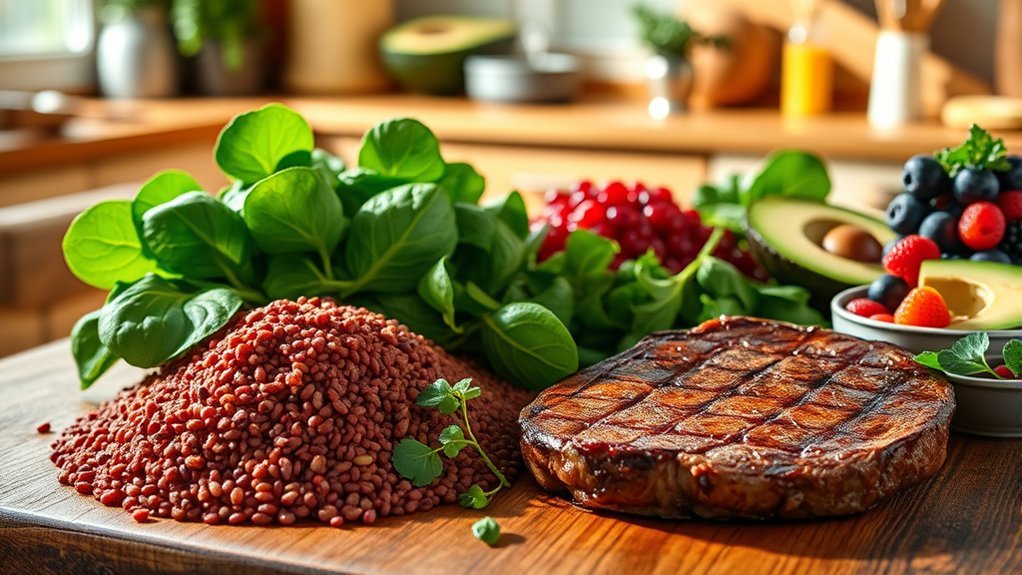Did you know that iron plays an important role in your child’s growth and brain development? As a parent, it’s important to understand how incorporating iron-rich foods can prevent deficiencies during those rapid growth phases. Fatigue, poor concentration, and a weakened immune system can all stem from insufficient iron intake. So, what are the best sources to include in your family’s meals, and how can you make them appealing? Let’s explore this significant topic further.
The Importance of Iron for Child Development
Iron plays an essential role in your child’s development, acting as a key player in various bodily functions. It’s critical for the production of hemoglobin, which carries oxygen in the blood. Without sufficient iron, your child may experience fatigue, poor concentration, and weakened immune function. Iron also supports cognitive development, enhancing memory and learning capabilities. Children are particularly vulnerable to iron deficiency, especially during rapid growth phases. This can lead to long-term developmental delays if not addressed. To guarantee your child gets enough iron, it’s important to be aware of their dietary needs and monitor their intake. Regular check-ups with a pediatrician can help identify any deficiencies early on, allowing for timely interventions.
Top Iron-Rich Foods for Kids
Ensuring your child gets enough iron is essential, and incorporating iron-rich foods into their diet can make a significant difference. Here are some top options you should consider:
- Red meat: Beef and lamb are excellent sources of heme iron, which is easily absorbed by the body.
- Poultry: Chicken and turkey provide a good amount of iron while being versatile for various meals.
- Legumes: Beans, lentils, and chickpeas are great plant-based options, high in iron and fiber.
- Leafy greens: Spinach and kale are packed with non-heme iron and can be added to smoothies or salads.
Signs of Iron Deficiency in Children
How can you tell if your child might be lacking in iron? Watch for signs like fatigue, irritability, or pale skin. If your child seems unusually tired or has low energy during activities, it could indicate low iron levels. You might also notice decreased appetite or difficulty concentrating in school. Other symptoms include frequent infections, since iron is essential for a healthy immune system. If your child complains of headaches or dizziness, this could also be a red flag. Keep an eye out for unusual cravings, like chewing on ice or dirt, known as pica. If you suspect iron deficiency, consult your pediatrician for proper testing and guidance. Early detection is key to ensuring your child’s health and well-being.
Tips for Incorporating Iron Into Family Meals
When planning family meals, it’s essential to include foods rich in iron to support your child’s health. Here are some practical tips to incorporate iron into your meals:
- Choose lean meats: Beef, chicken, and turkey are excellent sources of heme iron, which is more easily absorbed by the body.
- Include legumes: Beans, lentils, and chickpeas are great plant-based options that provide non-heme iron.
- Add leafy greens: Spinach, kale, and Swiss chard can boost iron intake, especially when paired with vitamin C-rich foods.
- Opt for fortified cereals: Many breakfast cereals are fortified with iron, making them a convenient choice for breakfast or snacks.
Fun Recipes to Boost Iron Intake
Incorporating iron-rich foods into your family’s diet can be both enjoyable and straightforward with the right recipes. Try a hearty spinach and chickpea stew, packed with both iron and flavor. Sauté onions and garlic, add fresh spinach, and mix in canned chickpeas for a quick meal.
Another fun option is iron-fortified oatmeal topped with sliced bananas and a sprinkle of nuts. This breakfast not only boosts iron but also provides essential nutrients for energy.
For snacks, consider roasted pumpkin seeds—easy to prepare and rich in iron.
Lastly, blend up a smoothie with kale, fortified almond milk, and a scoop of peanut butter. These recipes not only enhance iron intake but also make mealtime exciting for everyone!
Frequently Asked Questions
Can Excessive Iron Intake Be Harmful to Children?
Yes, excessive iron intake can be harmful to children. It may lead to iron overload, causing damage to organs and impairing absorption of other essential nutrients. Always consult a healthcare professional before making significant dietary changes.
How Does Iron Absorption Differ Between Plant and Animal Sources?
Iron absorption from animal sources is like a well-oiled machine—efficient and direct—while plant sources, rich in non-heme iron, require vitamin C for better absorption. You’ll benefit from combining foods for ideal iron intake.
Are There Any Medications That Affect Iron Absorption?
Yes, certain medications like antacids, proton pump inhibitors, and some antibiotics can affect iron absorption. If you’re taking these, consult your healthcare provider to guarantee you’re meeting your iron needs effectively while on medication.
What Role Does Vitamin C Play in Iron Absorption?
Vitamin C enhances iron absorption by converting it into a more absorbable form. When you pair vitamin C-rich foods like citrus fruits with iron sources, you greatly boost your body’s ability to take in iron effectively.
Can Iron Supplements Cause Any Side Effects in Children?
Yes, iron supplements can cause side effects in children. You might notice stomach upset, constipation, or dark stools. Always consult a healthcare professional before starting supplements to guarantee safety and appropriate dosage for your child.
Conclusion
Incorporating iron-rich foods into your child’s diet isn’t just a choice; it’s essential for their growth and development. Did you know that around 1 in 10 children in the U.S. experience iron deficiency? That’s a staggering statistic that highlights the importance of vigilance in your meal planning. By prioritizing sources like red meat, legumes, and leafy greens, you can help guarantee your child thrives, both physically and cognitively. Healthy meals today lay the foundation for a stronger tomorrow.
